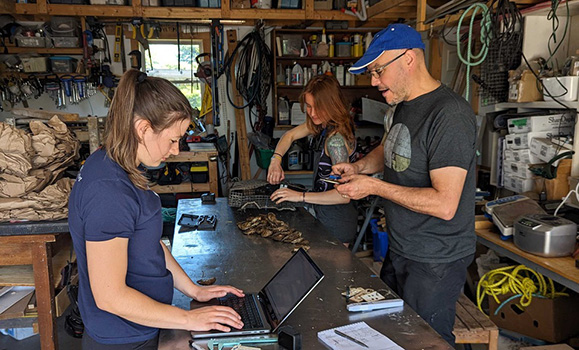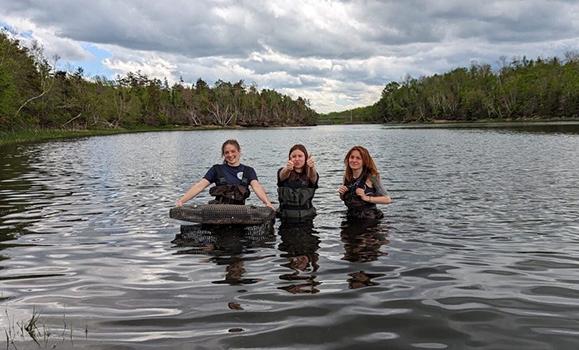Three cages filled with oysters, tied together with rope and held underwater with cinder blocks are nestled in a small alcove next to Boat Harbour in an innovative trial that could help clean up one of Nova Scotia's most polluted marine sites.
The rough-hewn mollusks — dubbed 'ecosystem engineers' for their ability to filter gallons of water a day — have been used around the world to clarify water and remove pollutants, provide habitat for hundreds of species and create natural defences against storms by muting the force of large waves.
Now they're being tested in a body of water near Boat Harbour (or A'se'k in Mi'kmaq), a tidal estuary that was converted into a treatment basin for effluents from a local pulp mill, which transformed the area and restricted the First Nation's traditional use of the harbour due to a toxic sludge that settled on the bottom.
Natural filtration
Dr. Ramon Filgueira, an associate professor in Dalhousie's Marine Affairs Program, is leading the research project that is evaluating the potential of oysters to be used as a filtration system since they naturally filter water, which can increase water quality and lessen overabundant algae growth.
First, he and his team have to determine whether the oysters can survive in the area.
"This method works, that's well known — we have many examples around the world where you place filter feeders in the water and they improve water clarity," Dr. Filgueira says of the nature-based solution.
"What's important to consider is the welfare of these organisms. We cannot say, 'Let's put one million oysters there,' if the water is so polluted that they are going to die in a month. So that's why this project was meant to be a pilot, and it is not located in the most polluted area."

The team acquired 225 bivalves from ShanDaph Oysters, a farm on nearby Big Island, and placed them in a pool of water that receives water flowing out of Boat Harbour. They are tracking how much they are feeding, how much they grow and how much they filter. In ideal situations, a single oyster can filter six to seven litres an hour or 50 gallons a day.
"This is just a good news story all around and is an idea that needs to be explored more. We're big proponents of oysters and what they can do for the environment," says ShanDaph co-owner and farmer Philip Docker.
"What I look most forward to in Boat Harbour is seeing the establishment of an oyster bed, which creates the ecosystem needed in an intertidal estuary so that we can have a much broader ecosystem because right now certain animals are not going to go into those dead zones."
Local collaboration
Dr. Filgueira is collaborating with the Pictou Landing First Nation (PLFN) on this initial pilot, which will inform site suitability and capacity for an oyster remediation project in the region. It is being funded by the Ocean Frontier Institute, with support from Centre for Marine Applied Research and ShanDaph Oysters.
"It's very exciting to look forward to see what great things we will see in the future as a nature-based solution to the pollution that has plagued Boat Harbour," says Tina Kelly of PLFN.

Dr. Ramon Filgueira (right) with team members Jasmine Talevi (left) and Kat Kabanova.
Boat Harbour / A'se'k played an important role in the life and culture of the Mi’kmaq for centuries until it became a treatment basin for the paper mill in 1967. From that point until early 2020, the harbour received wastewater from the pulp mill at Abercrombie Point. Studies have found that sediment in the harbour includes a range of contaminants, such as cadmium, dioxins, furans, mercury and petroleum hydrocarbons.
"This area would be perfect for our idea — all water needs to go through this narrow toward the ocean and is a perfect area to establish a natural biofilter that protects the ocean from Boat Harbour during the restoration process," says Dr. Filgueira.
"It is great. I love my research to be applied in the real world, but this is even beyond that and plays an ecological role in helping this community and increasing awareness about what bivalves are and what they do!"
A global trend
The nature-based solution is being used in jurisdictions around the globe. The Billion Oyster Project was started in 2014 and is restoring oyster reefs in New York Harbor, which once had 220,000 acres of oyster reefs. The group hopes to restore one billion oysters to the harbour by 2035.
In Europe, the Native Oyster Restoration Alliance is working to restore a European oyster and its habitat in areas of current or historical distribution.

From left: researchers Jasmine Talevi (Dalhousie), Davonia Augustine (Pictou Landing First Nation) and Kat Kabanova (Dalhousie).
Dr. Filgueira's team is also working with a graduate student and Davonia Augustine, a local youth from PLFN as a research assistant, to help with field work, while also gaining scientific knowledge and training through visits to the Halifax lab. By gathering this preliminary data, they will be able to assess if a full pilot project deployment is feasible. It will also lay the foundations for a longer-term partnership with PLFN, whose approval and collaboration are essential for future work in the area.
"The training and community engagement will raise awareness about the use of nature-based solutions to remediate environmental issues, which will contribute to the sustainable management of coastal communities," says Dr. Filgueira. "Restoration activities using oysters can be easily implemented and monitored by citizens, which provides a tool for communities to become stewards of the project when fully implemented."

